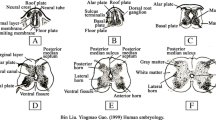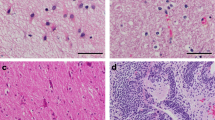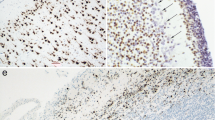Abstract
Background
The present diagnosis of teratomas is limited to visual examination of their tissues. For the sake of treatment, teratomas are graded according to degrees of nerve tissue maturation. Mature fetal nerve tissue contains the astrocyte-specific intermediate filament protein, the glial fibrillary acidic protein (GFAP). This study aimed to investigate GFAP expressions in the nerve tissue of immature and mature teratomas, and to evaluate if GFAP is indicative of teratoma maturation in pediatric patients.
Methods
Nerve tissue specimens were collected from immature (10 children) and mature teratomas (45 children). Nerve tissue specimens as a control group were taken from 33 children with neuroblastoma. GFAP expression of the specimens was studied by immunohistochemical and semi-quantitative analyses.
Results
GFAP expression was low in the nerve tissue of immature teratomas and high in that of mature ones. A semi-quantitative analysis confirmed statistically significant difference between the GFAP expressions of immature and mature teratomas (P=0.0001).
Conclusion
GFAP is highly expressed in the nerve tissue of mature teratomas and low in that of immature ones, suggesting that the GFAP expression is a meaningful indicator of teratoma maturation. It is helpful for pathologists to diagnose and classify teratomas.
Similar content being viewed by others
References
Harms D, Zahn S, Göbel U, Schneider DT. Pathology and molecular biology of teratomas in childhood and adolescence. Klin Padiatr 2006;218:296–302.
Gonzalez-Crussi F. Extragonadal teratoma. Atlas of tumor pathology, 2nd series, fascicle 18. Washington, DC: Armed Forces Institute of Pathology, 1982.
Heifetz SA, Cushing B, Giller R, Shuster JJ, Stolar CJ, Vinocur CD, et al. Immature teratomas in children: pathologic considerations: a report from the combined Pediatric Oncology Group/Children’s Cancer Group. Am J Surg Pathol 1998;22:1115–1124.
Notohara K, Hsueh CL, Awai M. Glial fibrillary acidic protein immunoreactivity of chondrocytes in immature and mature teratomas. Acta Pathol Jpn 1990;40:335–342.
Simon R, Mirlacher M, Sauter G. Tissue microarrays. Biotechniques 2004;36:98–105.
Culine S, Lhomme C, Kattan J, Michel G, Duvillard P, Droz JP. Pure malignant immature teratoma of the ovary: the role of chemotherapy and second-look surgery. Int J Gynecol Cancer 1995;5:432–437.
Göbel U, Calaminus G, Schneider DT, Koch S, Teske C, Harms D. The malignant potential of teratomas in infancy and childhood: the MAKEI experiences in non-testicular teratoma and implications for a new protocol. Klin Padiatr 2006;218:309–314.
Cushing B, Giller R, Ablin A, Cohen L, Cullen J, Hawkins E, et al. Surgical resection alone is effective treatment for ovarian immature teratoma in children and adolescents: a report of the pediatric oncology group and the children’s cancer group. Am J Obstet Gynecol 1999;181:353–358.
Fan Q, Huang H, Lian L, Lang J. Characteristics, diagnosis and treatment of hepatic metastasis of pure immature ovarian teratoma. Chin Med J 2001;114:506–509.
Mann JR, Gray ES, Thornton C, Raafat F, Robinson K, Collins GS, et al. Mature and immature extracranial teratomas in children: the UK Children’s Cancer Study Group Experience. J Clin Oncol 2008;26:3590–3597.
Kim E, Bae TS, Kwon Y, Kim TH, Chung KW, Kim SW, et al. Primary malignant teratoma with a primitive neuroectodermal tumor component in thyroid gland: a case report. J Korean Med Sci 2007;22:568–571.
Rutka JT, Smith SL. Transfection of human astrocytoma cells with glial fibrillary acidic protein complementary DNA: analysis of expression, proliferation and tumorigenicity. Cancer Res 1993;53:3624–3631.
Malhotra S, Shnitkn T, Elabrink J. Reactive astrocytes. A review. Cytobios 1990;61:133–160.
Kang MK, Ahn YC, Park JO, Han J, Lee KS. Lung metastasis from an immature teratoma of the nasal cavity masquerading as small cell carcinoma of the lung. Yonsei Med J 2006;47:571–574.
Author information
Authors and Affiliations
Corresponding author
Rights and permissions
About this article
Cite this article
Gu, S., Wu, YM., Hong, L. et al. Glial fibrillary acidic protein expression is an indicator of teratoma maturation in children. World J Pediatr 7, 262–265 (2011). https://doi.org/10.1007/s12519-011-0258-8
Received:
Accepted:
Published:
Issue Date:
DOI: https://doi.org/10.1007/s12519-011-0258-8




